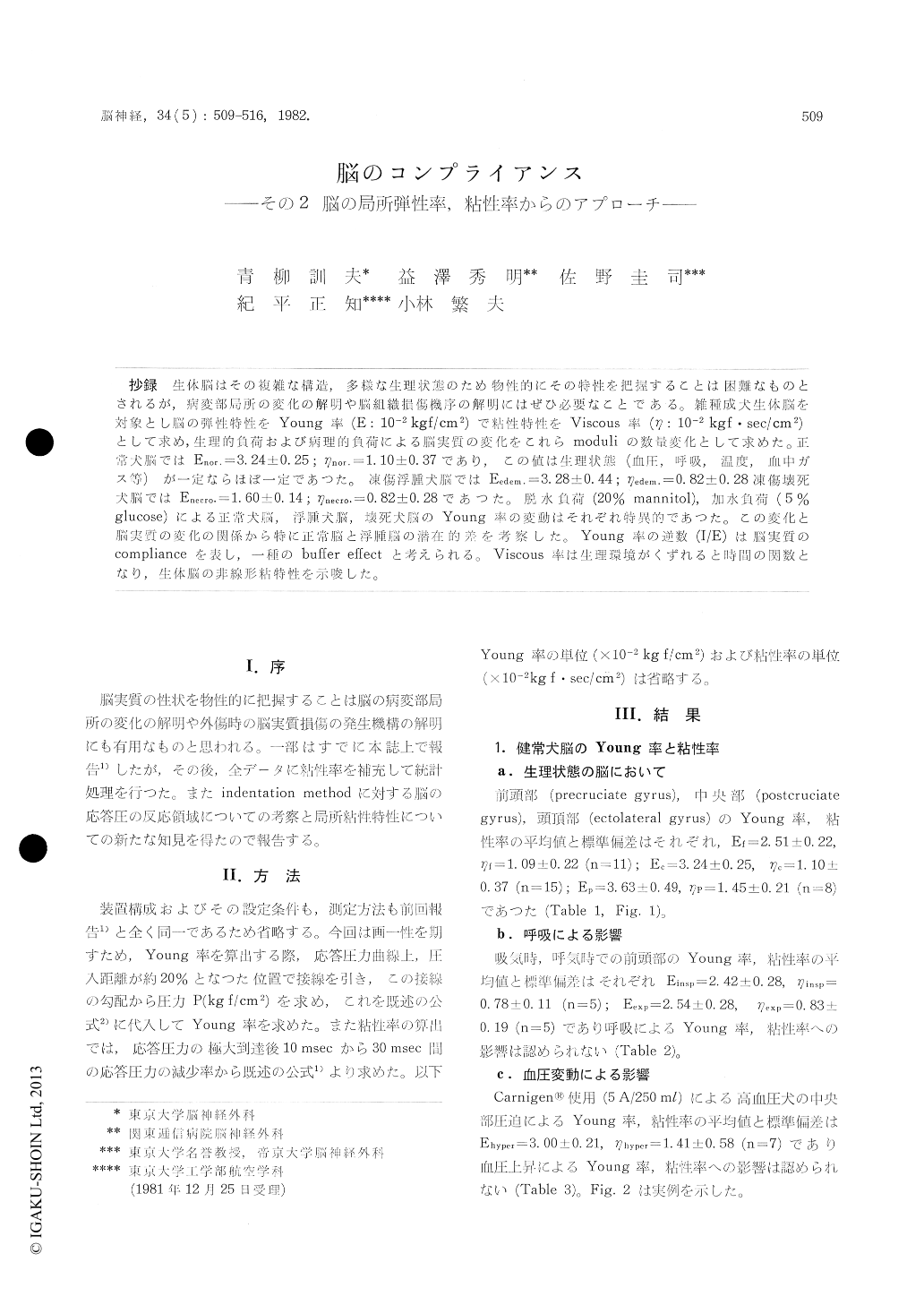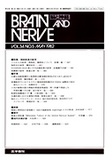Japanese
English
- 有料閲覧
- Abstract 文献概要
- 1ページ目 Look Inside
抄録 生体脳はその複雑な構造,多様な生理状態のため物性的にその特性を把握することは困難なものとされるが,病変部局所の変化の解明や脳組織損傷機序の解明にはぜひ必要なことである。雑種成犬生体脳を対象とし脳の弾性特性をYoung率(E:10−2kgf/cm2)で粘性特性をViscous率(η:10−2kgf・sec/cm2)として求め,生理的負荷および病理的負荷による脳実質の変化をこれらmoduliの数量変化として求めた。正常犬脳ではEnor.=3.24±0.25;ηnor.=1.10±0.37であり,この値は生理状態(血圧,呼吸,温度,血中ガス等)が一定ならほぼ一定であつた。凍傷浮腫犬脳ではEedem.=3.28±0.44;ηedem.=0.82±0.28凍傷壊死犬脳ではEnecro.=1.60±0.14;ηnecro.=0.82±0.28であつた。脱水負荷(20%mannitol),加水負荷(5%glucose)による正常犬脳,浮腫犬脳,壊死犬脳のYoung率の変動はそれぞれ特異的であつた。この変化と脳実質の変化の関係から特に正常脳と浮腫脳の潜在的差を考察した。Young率の逆数(I/E)は脳実質のcomplianceを表し,一種のbuffer effectと考えられる。Viscous率は生理環境がくずれると時間の関数となり,生体脳の非線形粘特性を示唆した。
It is important to have informations about physical property of the brain in order to elucidate both the physical changes of the morbid brain and the physical mechanism of the traumatic brain injury. Under the hypothesis that reaction of the alive brain to the dynamic load can be compared to the Max-well-Voigt three dementional model, elastic pro-perty of the brain was obtained as the Young's modulus (E:10-2Kgf/cm2) of which error was less than 10%, and viscous property of the brain as the Viscous modulus (η:10-2Kgf・sec/cm2). And it was confirmed that the reactive pressure of the brain to dynamic load came from the surface to about 15 mm depth of the brain. In this report, experi-ments were done on the alive normal brains, the edematous ones and necrotic ones which were pro-duced by the cold injury (dry ice-aceton) in dogs (9.0~16.0 Kg).
In the normal brain, E=3.24±0.25,η=1.10± 0.37 and these moduli were also stable when the physical conditions of the brain were stable. Under the dehydration by 20% mannitol, E increased in its value (p<0.01). But under the hydration by 5% glucose, E did not change at all. In the ed-ematous brain, E=3. 28±0.44,η=1.74±0.06 and E of the edematous brain was almost same as that of normal ones, but under the dehydration, E of the edematous brain decreased (p <0.10), on the other hand it increased in its value under the hydration (p<0.05).
In the necrotic brain, E=1. 60+0. 14, η=0.82± 0.28. Both moduli were of lower values and moreover they did not change its values at all under dehydration and hydration.
As Young's modulus is the elastic index of the brain, the converse (1/E) should be compliance of the brain, that is to say, buffer effect of the brain. As for the compliance, the necrotic brain has maximum buffer effect and the over-hydrated ed-ematous brain and the dehydrated normal ones have minimum buffer effect.
From analysing the changes of the viscous moduli. it became clear that the viscous moduli took quite different functions in alive brains and in fatal ones, and it was suspected that the alive brain might not be so simple in its viscoelastic property.

Copyright © 1982, Igaku-Shoin Ltd. All rights reserved.


